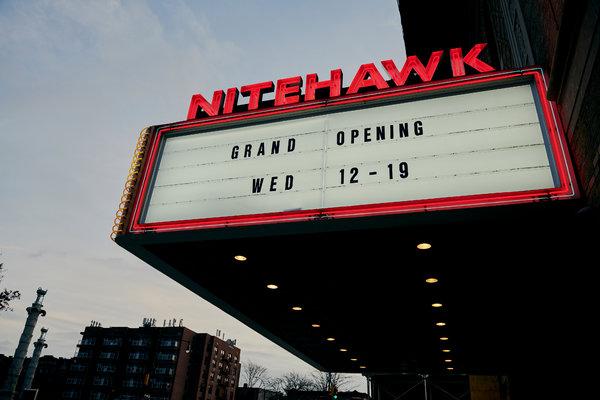Nitehawk Prospect Park Is Finally Ready, Promising Art-House Movies (and Cleaner Floors) – The New York Times
Supported by
Nitehawk Prospect Park Is Finally Ready, Promising Art-House Movies (and Cleaner Floors)
In recent years, New Yorkers have been forced to bid farewell to several beloved movie theaters. Sunshine Cinema on the Lower East Side, gone. Ziegfeld Theater in Midtown, gone. Lincoln Plaza Cinema on the Upper West Side, gone.
It wasn’t so out of the ordinary, then, when the decrepit Pavilion theater in Park Slope, Brooklyn, went dark in 2016. Less ordinary, perhaps, is that it won’t be converted into offices or condos, as originally thought, but will reopen as a new and improved cinema: Nitehawk Prospect Park, a boutique multiplex, which after numerous delays is finally opening on Dec. 19.

The new theater — Nitehawk’s second location, expanding on the success of the original in Williamsburg — represents a significant upgrade to the Pavilion. Photos uploaded to the Pavilion’s Yelp page from before it closed show broken seats, trash-strewn floors and filthy restrooms. Rumors of bedbugs inspired one patron to create his own seat cover.
“It wasn’t the cleanest place,” said Mark Grashow, another patron and a retired high school teacher who has lived near the theater for 45 years. “Its reputation got worse and worse and worse.”
That shabby interior practically defined the Pavilion in its final days, making the newly refurbished space seem luxurious by comparison. Upgrades include elevators, comfortable seating, in-theater food-and-drink service and a second-floor bar overlooking Prospect Park. Similar to Nitehawk’s original three-screen location, the new seven-screen multiplex will cater to cinephiles, going heavy on indies and foreign films and offering special series like baby-friendly, brunch and midnight screenings.
The Park Slope location preserves the retro vibe of Nitehawk Williamsburg — the top floors feature a curated VHS vault and cocktail table arcades with games like Ms. Pac-Man — but the scale is greater, making room for blockbusters and family-friendly movies in addition to the art-house fare. The 650-seat, 34,000-square-foot space is more than triple the size of Williamsburg’s. Its largest single theater seats 194, more than all three Williamsburg screens combined.
Restoring the space was no easy feat. Most of the Pavilion’s interior had to be overhauled, but the Nitehawk team was able to salvage marble stairs that were hidden under two layers of carpet. The team also saved most of the original plasterwork and a balcony dating back to the 1920s.
“It was in serious disrepair,” said Matthew Viragh, the founder of Nitehawk, during a recent tour of the space. “There were rats the size of dogs in here. And they weren’t scared of anything either.”
The history of the site, located at 188 Prospect Park West, mirrors changes that have reshaped the neighborhood for over a century. The site’s first theater, built in a neo-Renaissance style popular in the Gilded Age, opened in 1908 as the Marathon, a vaudeville theater with 600 seats. As the borough continued to grow, the Marathon was demolished and rebuilt in 1928 as the Sanders, a much larger and more modern single-screen cinema.
But as neighborhoods like Park Slope declined in the 1970s and ’80s, so did many local theaters. The Sanders closed in 1978, and it stayed dark for nearly two decades.
Then in 1996, as a wave of young working professionals began moving to the neighborhood, the space was reopened as the Pavilion, a three-screen multiplex. The director Eliza Hittman (“Beach Rats”) grew up in Prospect Park South and was 16 years old when the Pavilion opened.
“It was a bit of an event,” she said. “That building had sat there desolate, abandoned, for so long that when they said a movie theater was reopening in the space, it created a lot of excitement.”
But while the Pavilion was beloved by many a moviegoer, it didn’t have the best track record.
“In a lot of ways, the theater follows this pattern of gentrification, except that the people who happened to redevelop the Pavilion in the 1990s don’t seem to have done a particularly good job at it,” said Julie Golia, the director of public history at the Brooklyn Historical Society, laughing.
“It’s not like it’s this lovingly restored, yuppie, crafted cocktails kind of place,” she continued, referring to the Pavilion. “It still has that rough-around-the-edges reputation, and one of not the greatest service.”
Opened as a home for first-run and independent films, the Pavilion eventually strayed from its original vision, Hittman said. But neither that nor the bedbug rumors put off loyalists like the filmmaker Alex Ross Perry (“Golden Exits,” “Queen of Earth”), who lived five blocks away for about 10 years.
“Since when are sticky floors in a movie theater an anomalous thing that’s worth getting upset over?” he said.
Perry said that for a time he visited the Pavilion on a weekly basis and saw nearly 250 films there. His fondest memories were of late-night screenings of horror movies on opening weekend.
“It was very much my neighborhood theater, which is what I liked about it,” he said.
Viragh said he hoped the new space, even with all the upgrades, would continue to serve that purpose.
“We’re an independent movie theater that wants to be a neighborhood movie theater,” he said.
Related Coverage
Bringing a New Nitehawk to a Tattered Art Deco Cinema
Boutique Cinemas Offer More than Popcorn and Snacks
Advertisement
Let’s block ads! (Why?)

